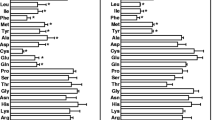Abstract
Kynurenic acid is an endogenous product of the tryptophan metabolism, and as a broad-spectrum antagonist of excitatory amino acid receptors may serve as a protective agent in neurological disorders. The use of kynurenic acid as a neuroprotective agent is rather limited, however, because it has only restricted ability to cross the blood–brain barrier. Accordingly, new kynurenic acid analogues which can readily cross the blood–brain barrier and exert their complex anti-excitotoxic activity are greatly needed. Such a novel analogue, 2-(2-N,N-dimethylaminoethylamine-1-carbonyl)-1H-quinolin-4-one hydrochloride, has been developed and tested. In an in vitro electrophysiological study, in which its properties were compared with those of kynurenic acid, the new analogue behaved quite similarly to kynurenic acid: in the micromolar range, its administration led to a decrease in the amplitudes of the field excitatory postsynaptic potentials in the CA1 region of the hippocampus, while in nanomolar concentrations it did not give rise to inhibition, but, in fact, facilitated the field excitatory postsynaptic potentials. Moreover, the new analogue demonstrated similar protective action against PTZ-induced facilitation to that observed after kynurenic acid administration. The findings strongly suggest that the neuroactive effects of the new analogue are comparable with those of kynurenic acid, but, in contrast with kynurenic acid, it readily crosses the blood–brain barrier. The new analogue may therefore be considered a promising candidate for clinical studies.





Similar content being viewed by others
References
Birch PJ, Grossman CJ, Hayes AG (1988) Kynurenate and FG9041 have both competitive and non-competitive antagonist actions at excitatory amino acid receptors. Eur J Pharmacol 151:313–315
Cunningham RF, Israeli ZH, Dayton PG (1981) Clinical pharmacokinetics of probenecid. Clin Pharmacokinet 6:135–151
Fukui S, Schwarcz R, Rapoport SI, Takada Y, Smith QR (1991) Blood-brain barrier transport of kynurenines: implications for brain synthesis and metabolism. J Neurochem 56:2007–2017
Füvesi J, Somlai C, Németh H, Varga H, Kis Z, Farkas T, Károly N, Dobszay M, Penke Z, Penke B, Vécsei L, Toldi J (2004) Comparative study on the effects of kynurenic acid and glucosamine-kynurenic acid. Pharmacol Biochem Behav 77:95–102
Hilmas C, Pereira EF, Alkondon M, Rassoulpour A, Schwarz R, Albuquerque EX (2001) The brain metabolite kynurenic acid inhibits alpha7 nicotinic receptor activity and increases non-alpha7 nicotinic receptor expression: physiopathological implication. J Neurosci 21:7463–7473
Kessler M, Terramani T, Lynch G, Baudry M (1989) A glycine site associated with N-methyl-d-aspartic acid receptors: characterization and identification of a new class of antagonists. J Neurochem 52:1319–1328
Knyihár-Csillik E, Mihály A, Krisztin-Peva B, Robotka H, Szatmári J, Fülöp F, Toldi J, Csillik B, Vécsei L (2008) The kynurenate analog SZR-72 prevents the nitroglycerol-induced increase of c-fos immunoreactivity in the rat caudal trigeminal nucleus: comparative studies of the effects of SZR-72 and kynurenic acid. Neurosci Res 61:429–432
Marchi M, Risso F, Viola C, Cavazzani P, Raiteri M (2002) Direct evidence that release-stimulating alpha7 nicotinic cholinergic receptors are localized on human and rat brain glutamatergic axon terminals. J Neurochem 80:1071–1078
Muir KW (2006) Glutamate-based therapeutic approaches: clinical trials with NMDA antagonists. Curr Opin Pharmacol 6:53–60
Muir KW, Lees KR (1995) Clinical experience with excitatory amino acid antagonist drugs. Stroke 26:503–513
Németh H, Toldi J, Vécsei L (2005) Role of kynurenines in the central and peripheral nervous systems. Curr Neurovasc Res 2:249–260
Robotka H, Toldi J, Vecsei L (2008) l-Kynurenine: metabolism and mechanism of neuroprotection. Future Med 3:169–188
Rózsa É, Robotka H, Nagy D, Farkas T, Sas K, Vécsei L, Toldi J (2008a) The pentylentetazole-induced activity in the hippocampus can be inhibited by the conversion of l-kynurenine to kynurenic acid: an in vitro study. Brain Res Bull 76:474–479
Rózsa É, Robotka H, Vécsei L, Toldi J (2008b) The janus-face kynurenic acid. J Neural Transm. 115:1087–1091
Sas K, Robotka H, Toldi J, Vecsei L (2007) Mitochondria, metabolic disturbances, oxidative stress, and kynurenine system, with focus on neurodegenerative disorders. J Neurol Sci 257:221–239
Stone TW (2000) Development and therapeutic potential of kynurenic acid and kynurenine derivatives for neuroprotection. Trends Pharmacol Sci 21:149–154
Stone TW, Addae JI (2002) The pharmacological manipulation of glutamate receptors and neuroprotection. Eur J Pharmacol 447:285–296
Stone TW, Forrest CM, Mackay GM, Stoy N, Darlington LG (2007) Tryptophan, adenosine, neurodegeneration and neuroprotection. Metab Brain Dis 22:337–352
Vécsei L, Miller J, MacGarvey U, Beal MF (1992a) Kynurenine and probenecid inhibit pentylenetetrazol- and NMDA-induced seizures and increase kynurenic acid concentrations in the brain. Brain Res Bull 28:233–238
Vécsei L, Miller J, MacGarvey U, Beal MF (1992b) Effects of kynurenine and probenecid on plasma and brain tissue concentrations of kynurenic acid. Neurodegeneration 1:17–26
Acknowledgments
The present study was supported by OTKA grant K 75628, TÁMOP-4.2.2/08/1/2008-0002 and JSPS/110. T. F. is a Bolyai Fellow of the Hungarian Academy of Sciences.
Author information
Authors and Affiliations
Corresponding author
Rights and permissions
About this article
Cite this article
Marosi, M., Nagy, D., Farkas, T. et al. A novel kynurenic acid analogue: a comparison with kynurenic acid. An in vitro electrophysiological study. J Neural Transm 117, 183–188 (2010). https://doi.org/10.1007/s00702-009-0346-2
Received:
Accepted:
Published:
Issue Date:
DOI: https://doi.org/10.1007/s00702-009-0346-2




